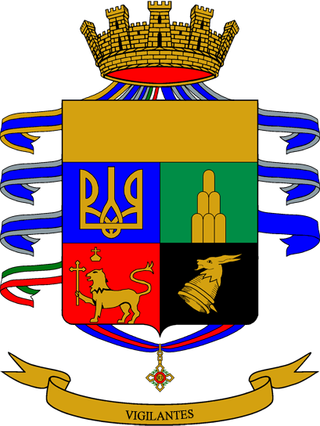
The 2nd Alpini Regiment is a mountain warfare regiment of the Italian Army based in Cuneo in Piedmont. The regiment belongs to the Italian Army's Alpini infantry speciality and is assigned to the Alpine Brigade "Taurinense". On 1 November 1882, the Royal Italian Army formed the 2nd Alpini Regiment, which had its recruiting area in the Maritime Alps and Cottian Alps. During World War I the regiment expanded to ten battalions, which fought separately in the alpine areas of the Italian front.

The Alpine Brigade "Cadore" was a light Infantry brigade of the Italian Army, specializing in mountain warfare. Its core units were Alpini, the mountain infantry corps of the Italian Army, that distinguished itself in combat during World War I and World War II. The brigade was based in the Italian provinces of Belluno and Vicenza with its headquarters Belluno. The brigade was disbanded in 1997.
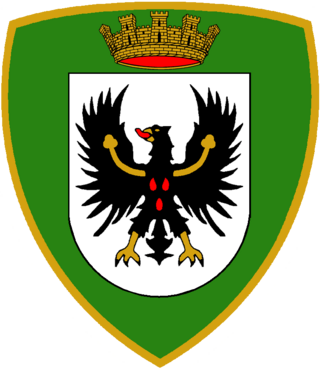
The Alpine Brigade "Tridentina" was a light Infantry brigade of the Italian Army, specializing in mountain warfare. Its core units were Alpini, the mountain infantry corps of the Italian Army, that distinguished itself in combat during World War I and World War II. The Alpine Brigade "Tridentina" carried on the colours and traditions of the WWII 2nd Alpine Division "Tridentina".

The 6th Alpini Regiment is a mountain warfare training regiment of the Italian Army based in Bruneck in South Tyrol. The regiment belongs to the Italian Army's Alpini infantry speciality and is assigned to the Alpine Training Center in Aosta. On 1 November 1882, the Royal Italian Army formed the 6th Alpini Regiment, which had its recruiting area initially in the Vicentine Alps, Bellunes Alps, Carnic Alps, Carnic Prealps, and the Western side of the Julian Alps. In 1887 the regiment was split to form the 7th Alpini Regiment and afterwards the regiment's recruiting area consisted of the Vicentine Alps.

The 7th Alpini Regiment is a mountain warfare regiment of the Italian Army based in Belluno in Veneto. The regiment belongs to the Italian Army's Alpini infantry speciality and is assigned to the Alpine Brigade "Julia". On 1 August 1887, the Royal Italian Army formed the 7th Alpini Regiment by splitting the 6th Alpini Regiment. The new regiment's recruiting area initially consisted of the valleys of the Bellunes Alps, Carnic Alps, Carnic Prealps, and the Western side of the Julian Alps. In 1909 the regiment was split to form the 8th Alpini Regiment and afterwards the regiment's recruiting area consisted of the Bellunes Alps.

The 8th Alpini Regiment is a mountain warfare regiment of the Italian Army based in Venzone in Friuli-Venezia Giulia. The regiment belongs to the Italian Army's Alpini infantry speciality and is assigned to the Alpine Brigade "Julia". On 1 October 1909, the Royal Italian Army formed the 8th Alpini Regiment by splitting the 7th Alpini Regiment. The new regiment's recruiting area consisted of the Carnic Alps, Carnic Prealps, and the Western side of the Julian Alps. During World War I the regiment expanded to ten battalions, which fought separately in the alpine areas of the Italian front.

The 9th Alpini Regiment is a mountain warfare regiment of the Italian Army based in L'Aquila in Abruzzo. The regiment belongs to the Italian Army's Alpini infantry speciality and is assigned to the Alpine Brigade "Taurinense". The regiment was formed by the Royal Italian Army on 1 July 1921. In 1935 the regiment was assigned to the 3rd Alpine Division "Julia", with which it served during World War II in the Greco-Italian War, during which the division suffered heavy losses. For its service and sacrifice on the Greek Front the 9th Alpini Regiment was awarded Italy's highest military honor the Gold Medal of Military Valor. In summer 1942 the division was transferred to the Eastern Front in the Soviet Union, where it was destroyed in winter 1942-43 during the Soviet Operation Little Saturn. The remnants of the division were repatriated in spring 1943. For its service and sacrifice on the Eastern Front the 9th Alpini Regiment was awarded a second Gold Medal of Military Valor. On 8 September 1943, the Armistice of Cassibile was announced and invading German forces disbanded the 9th Alpini Regiment.

The Alpini Paratroopers Battalion "Monte Cervino" is a Special Forces unit of the Italian Army. The battalion belongs to the Italian Army's Alpini infantry speciality and is assigned to the 4th Alpini Paratroopers Regiment. In November 1915, the Royal Italian Army's 4th Alpini Regiment formed the Alpini Battalion "Monte Cervino", which served during World War I on the Italian front. For its conduct and valor during the war the battalion, which was disbanded in 1919, was awarded a Silver Medal of Military Valor.
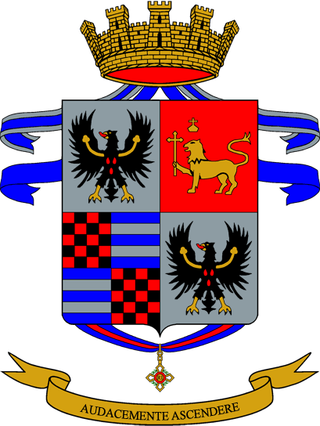
The 11th Alpini Regiment is an inactive mountain warfare regiment of the Italian Army last based in Bruneck in South Tyrol. The regiment belongs to the Italian Army's Alpini infantry speciality and was last assigned to the Alpine Brigade "Tridentina". The regiment was formed by the Royal Italian Army on 22 December 1935 and assigned assigned to the 5th Alpine Division "Pusteria", with which it participated in the Second Italo-Ethiopian War.

The 12th Alpini Regiment is an inactive mountain warfare regiment of the Italian Army last based in Pieve di Cadore in Veneto. The regiment belongs to the Italian Army's Alpini infantry speciality and was assigned to the Alpine Brigade "Cadore". The regiment was formed in 1992 and consisted of the Alpini Battalion "Pieve di Cadore", whose flag and traditions it inherited.

The 16th Regiment "Belluno" is an inactive mountain warfare regiment of the Italian Army last based in Belluno in Veneto. The regiment belongs to the Italian Army's Alpini infantry speciality and was a training unit last assigned to the Alpine Troops Command. The regiment was formed in 1991 and consisted of the Alpini Battalion "Belluno", whose flag and traditions it inherited.

The 15th Alpini Regiment is an inactive mountain warfare regiment of the Italian Army last based in Chiusaforte in Friuli-Venezia Giulia. The regiment belongs to the Italian Army's Alpini infantry speciality and was assigned to the Alpine Brigade "Julia". The regiment was formed in 1992 and consisted of the Alpini Battalion "Cividale", whose flag and traditions it inherited. The regiment's anniversary falls on 5 January 1943, the day of the Battle of Novaya Kalitva in the Soviet Union.

The 14th Alpini Regiment in a mountain warfare unit of the Italian Army based in Udine in Friuli-Venezia Giulia. The regiment belongs to the Italian Army's Alpini infantry speciality. The regiment was formed in 1993 and consisted of the Alpini Battalion "Tolmezzo", whose flag and traditions it inherited. The regiment was disbanded in 2005. On 1 October 2022, the flag and traditions of the 14th Alpini Regiment were assigned to the Command and Tactical Supports Unit "Julia" of the Alpine Brigade "Julia", which on the same day was renamed 14th Alpini Command and Tactical Supports Unit.

The 5th Alpine Division "Pusteria" was a division of the Royal Italian Army during World War II, which specialized in mountain warfare. The Alpini are a mountain infantry corps of the Italian Army, that distinguished itself in combat during World War I and World War II. The division was formed in 1935 and based in the Puster Valley, which gave the division its name.
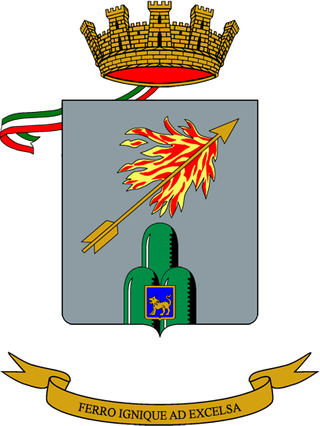
The 6th Mountain Artillery Regiment is an inactive mountain artillery regiment of the Italian Army, which was based in Bassano del Grappa in Veneto. The regiment was formed in 1941 by the Royal Italian Army with batteries that had served in World War I and been disbanded after the war. During World War II the regiment served in 1942 as occupation force in Montenegro and in 1943 in Liguria as coastal defence unit. After the announcement of the Armistice of Cassibile on 8 September 1943 the regiment was disbanded two days later by invading German forces.

The Comando Truppe Alpine or COMTA commands the Mountain Troops of the Italian Army, called Alpini and various support and training units. It is the successor to the 4º Corpo d'Armata Alpino of the Cold War. The Alpini are light Infantry units specializing in Mountain Combat. The subordinate units of the COMTA distinguished themselves during combat in World War I and World War II.
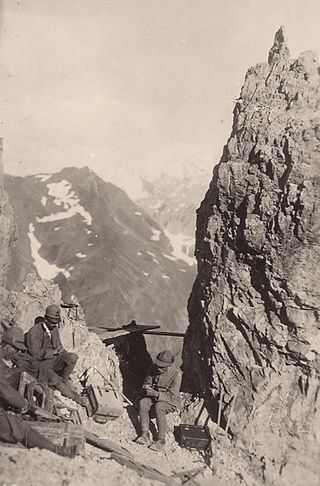
The Alpini are a specialised mountain warfare infantry corps of the Italian Army, which distinguished itself in World War I fighting in the Alps against Austro-Hungarian Kaiserjäger and the German Alpenkorps. The Alpini were supported by the Mountain Artillery, which both share the Cappello Alpino as identifying symbol. Below follow tables listing the regiments, battalions and groups, companies and batteries of the Alpini and Mountain Artillery active in World War I.
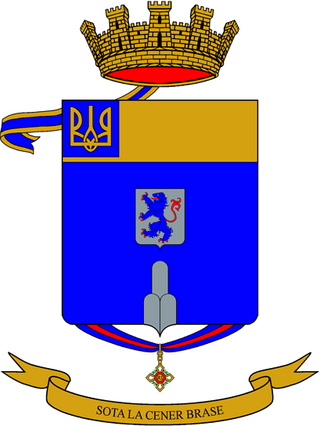
The Alpini Battalion "Val Chiese" is an inactive mountain warfare battalion of the Italian Army based last in Sterzing in South Tyrol. The battalion belongs to the Italian Army's Alpini infantry speciality and was assigned to the Alpine Brigade "Orobica". In 1915, the Royal Italian Army's 5th Alpini Regiment formed the Alpini Battalion "Val Chiese", which fought in World War I in the alpine areas of the Italian front. The battalion was disbanded in 1919.

The Alpini Battalion "Val Brenta" is an inactive mountain warfare battalion of the Italian Army based last in Bruneck in South Tyrol. The battalion belongs to the Italian Army's Alpini infantry speciality and was assigned to the Alpine Brigade "Tridentina". In 1882, the Royal Italian Army formed the Battalion "Val Brenta", which four years later was renamed Alpini Battalion "Bassano". In 1915, the army formed a new Alpini Battalion "Val Brenta", which fought in World War I in the alpine areas of the Italian front. The battalion was disbanded in 1920. In September 1939, the "Val Brenta" battalion was reformed and in June 1940 the battalion participated in the Italian invasion of France. At the end of October 1940 the battalion was disbanded.

The Alpini Battalion "Val Tagliamento" is an inactive mountain warfare battalion of the Italian Army based last in Tolmezzo in Friuli-Venezia Giulia. The battalion belongs to the Italian Army's Alpini infantry speciality and was assigned to the Alpine Brigade "Julia". In 1882, the Royal Italian Army formed the Battalion "Val Tagliamento", which four years later was renamed Alpini Battalion "Gemona". In 1915, the army formed a new Alpini Battalion "Val Tagliamento", which fought in World War I in the alpine areas of the Italian front. The battalion was disbanded in 1920. In September 1939, the "Val Tagliamento" battalion was reformed and in June 1940 the battalion participated in the Italian invasion of France. In November 1940, the battalion was sent to Albania, where the battalion was attached to the 3rd Alpine Division "Julia", which had suffered heavy losses in the Greco-Italian War. In June 1941, after the Invasion of Yugoslavia, the battalion was sent to Montenegro on occupation duty. In August 1942, the battalion returned to Italy. At the end of 1942, the "Val Tagliamento" battalion was sent to occupied France on garrison duty. In July 1943, the battalion returned to Italy and was disbanded.






















